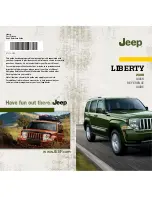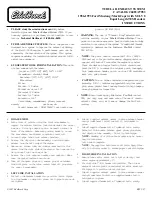
CAUTION!
After inspecting or adjusting the tire pressure, al-
ways reinstall the valve stem cap–if equipped. This
will prevent moisture and dirt from entering the
valve stem, which could damage the valve stem.
Inflation pressures specified on the placard are always
“cold tire inflation pressure”. Cold tire inflation pressure
is defined as the tire pressure after the vehicle has not
been driven for at least 3 hours, or driven less than 1mile
(1 km) after a 3 hour period. The cold tire inflation
pressure must not exceed the maximum inflation pres-
sure molded into the tire side wall.
Check tire pressures more often if subject to a wide range
of outdoor temperatures, as tire pressures vary with
temperature changes.
Tire pressures change by approximately 1 psi (7 kPa) per
12° F (7° C) of air temperature change. Keep this in mind
when checking tire pressure inside a garage, especially in
the winter.
Example: If garage temperature = 68° F (20° C) and the
outside temperature = 32° F (0° C) then the cold tire
inflation pressure should be increased by 3 psi (21 kPa),
which equals 1 psi (7 kPa) for every 12° F (7° C) for this
outside temperature condition.
Tire pressure may increase from 2 to 6 psi (13 to 40 kPa)
during operation. DO NOT reduce this normal pressure
build up or your tire pressure will be too low.
Tire Pressures for High Speed Operation
The manufacturer advocates driving at safe speeds
within posted speed limits. Where speed limits or condi-
tions are such that the vehicle can be driven at high
speeds, maintaining correct tire inflation pressure is very
important. Increased tire pressure and reduced vehicle
STARTING AND OPERATING
307
5
Summary of Contents for Ram Power Wagon
Page 2: ......
Page 8: ......
Page 40: ...Inserting Latch Plate In Use Position 40 THINGS TO KNOW BEFORE STARTING YOUR VEHICLE...
Page 68: ...Quad Cab Tether Strap Mounting 68 THINGS TO KNOW BEFORE STARTING YOUR VEHICLE...
Page 74: ......
Page 89: ...Blindspot Mirror Trailer Towing Position UNDERSTANDING THE FEATURES OF YOUR VEHICLE 89 3...
Page 110: ...110 UNDERSTANDING THE FEATURES OF YOUR VEHICLE...
Page 111: ...UNDERSTANDING THE FEATURES OF YOUR VEHICLE 111 3...
Page 112: ...112 UNDERSTANDING THE FEATURES OF YOUR VEHICLE...
Page 166: ...INSTRUMENTS AND CONTROLS 166 UNDERSTANDING YOUR INSTRUMENT PANEL...
Page 167: ...INSTRUMENT CLUSTER UNDERSTANDING YOUR INSTRUMENT PANEL 167 4...
Page 226: ...Operating Tips Chart 226 UNDERSTANDING YOUR INSTRUMENT PANEL...
Page 237: ...Angles A B C and D STARTING AND OPERATING 237 5...
Page 258: ...UNDERSTANDING THE FEATURES OF YOUR WINCH Winch Components 258 STARTING AND OPERATING...
Page 304: ...304 STARTING AND OPERATING...
Page 362: ......
Page 366: ...ENGINE COMPARTMENT 5 7L 366 MAINTAINING YOUR VEHICLE...
Page 420: ......
Page 450: ......
Page 451: ...INDEX 10...
















































